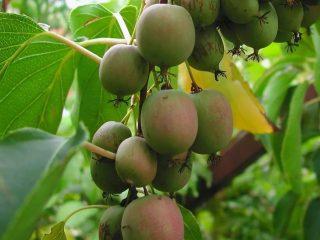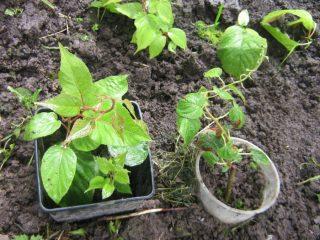Content
Actinidia in the Moscow region does not always produce a stable harvest. This is due to the characteristics of a particular variety. The perennial produces fruits similar to kiwi, but with a sweeter taste. The plant's homeland is the subtropics, but some specimens take root well in the Moscow region.
The best varieties of actinidia for the Moscow region and central Russia
Thanks to adaptive skills, culture is found in different countries. Through the efforts of scientists, it was possible to obtain winter-hardy varieties of actinidia suitable for cultivation in the middle zone and the Moscow region. Below are the most productive specimens with high characteristics.
Doctor Szymanowski
The variety Doctor Shimanovsky, bred by Polish botanists, can withstand cold temperatures down to -38 degrees. Regardless of weather and temperature conditions, actinidia produces an equally rich harvest. The liana is covered with greenish fruits with a blush. Gourmets rated the taste 9 out of 10 points.Along with the sweetness there is a slight sourness.

Actinidia berries smell like pineapple and apple
Adam
The Adam vine is more often used as a pollinator, since the male specimens have well-developed stamens. A distinctive feature of actinidia is its bright coloring.

Young foliage is green, which later changes to white, and by winter to pink, which is unusual for the Moscow region
In bright light conditions, the contrast of the leaves increases. The buds are small in size, noble white in color. During the flowering period they give off a lemon aroma.
September
Gardeners pay attention to the September variety because of its high yield. From one bush you can collect from 1 to 2 kg of fruit. They are very sweet, ribbed, with barely noticeable yellowish stripes on the sides. The foliage is heart-shaped and may change color due to lighting.

Actinidia buds form in the spring; in the Moscow region they bloom by early summer
Vitacola
The Vitacola variety was obtained in the Czech Republic and is the most winter-hardy of those listed. The liana produces berries three years after planting. The leaves are pale green, sometimes light red. The fruits are collected in groups of three. The buds are white in color with a characteristic lemon aroma. They begin to bloom in late spring.

The berries have an elongated shape, golden-green color, like many varieties of the Moscow region
Gourmand
Actinidia Gourmand with strong immunity, suitable for growing in the middle zone and the Moscow region. The liana reaches medium size. Strong plant tissues protect it from pests. The leaves have an olive color.The shoots are glossy and smooth to the touch. Slightly elongated berries are large in size.

Tasting score – 9.2/10 points
How to plant actinidia in the Moscow region
Actinidia has long ceased to be something exotic. Currently, it is widely cultivated in the Moscow region. For planting, select an area with nutritious soils. The main attention is paid to groundwater, the level of which must be sufficiently deep.
Landing in the Moscow region is carried out as follows:
- Dig a hole 60-70 cm in diameter. Check the humidity to understand how deep the groundwater is. Drainage material is laid in a uniform layer, about 20 cm.
- An organic additive consisting of leaf soil, wood ash and sand is added to the soil. It is also useful to use a bucket of humus, potassium salt and 200 g of superphosphate. Everything is mixed with the excavated soil.
- An actinidia seedling is placed in the center of the hole along with a lump of earth and buried. The soil near the roots is compacted by hand. The neck should be on the surface at a distance of 4 cm.
Growing actinidia in the Moscow region is not difficult; after planting, the crop is watered and mulched with a layer of straw; you can use other material
A distance of 200-250 cm is maintained between other seedlings. The more, the easier it is for the roots to absorb moisture. Male actinidia are planted separately from female ones.
Although the plant is undemanding for cultivation in the Moscow region, a neutral or slightly acidic substrate is desirable for it. For actinidia, you should find a place where it can receive maximum sunlight.As the seedling grows, it is placed on supports, not forgetting to provide shelter to protect it from drafts.
In a good way, you need to install trellises. You can buy them in a store or make them yourself. The vine is placed on a wire thread. Due to this arrangement, the ventilation of the shoots is improved and the risk of disease is reduced. Growing stems are placed vertically.
Actinidia care in the Moscow region
Knowing which varieties of actinidia are best to plant in the Moscow region does not guarantee 100% results. In order for the vine to bear fruit, basic care is required. Supports are installed for the crop, the main shoots are directed and tied up. The owner needs to remember three things - pruning, fertilizing and shelter.
Trimming
The shoots must be pruned so that the bush uses its reserve of strength to produce berries. In addition to increasing the yield, formative pruning makes actinidia neat. In the Moscow region, young seedlings are left as is.

The vine is pruned for the first time in the spring, and the procedure is repeated in the summer.
To reduce the growth rate in the Moscow region, pinch the stems.
Actinidia requires frequent pruning because it is a fast-growing plant. In the Moscow region, it is important to do this when actinidia is in a calm state. If the shoots intersect with each other or touch the soil, they are cut back. Unnecessary branches are also removed to improve lighting.
Top dressing
The taste of the berries depends on the fertility of the soil in the Moscow region.Using nutritional supplements, the owner will increase the immunity of actinidia, productivity, and frost resistance. Fertilizers can be used throughout the year - spring, summer and autumn.
In the Moscow region, nitrogen compounds are applied in April, and closer to May they switch to complex ones. In July, they focus on phosphorus and potassium, reducing the nitrogen content. In the fall, the last element is removed completely.
Preparing actinidia for winter in the Moscow region
In the Moscow region, it is necessary to cover actinidia in the early stages. Lianas older than three years do not need the procedure; they easily tolerate the winter.
When growing in the middle zone, the determining factor is temperature. In Siberia, actinidia is protected from the cold, regardless of the variety. In the Urals, making a shelter is also vital. In such regions there is no fear of winters with little snow, and plants are usually insulated with snow.
Actinidia that are not adapted to the climate of the Moscow region are removed from the trellises, pinned down and covered with a layer of peat. You can use other materials: agrofibre, spruce branches, dried leaves.

In the Moscow region, for reliability, the structure is insulated with spunbond
Diseases and pests
The immunity of actinidia depends on the variety. Many of them can withstand attacks from pests: bark beetles, caterpillars, and aphids. If an insect has eaten a bush, chemicals are used. In the Moscow region, damaged shoots should be removed immediately so as not to infect neighbors’ plantings.
For prevention in the spring, actinidia along with the soil is sprayed with Bordeaux mixture. The substance kills fungal spores, insect larvae, and viruses. Symptoms of infection may include spots on the shoots, leaf fall, and yellowing.In this case, fungicides or soda ash are used.
Harvest and storage
In the Moscow region, the liana produces berries in the third year, provided that external factors are favorable. The soft fruits are sweet, with a slight sourness. Actinidia contains more vitamin C than other citrus fruits. Ripe berries quickly deteriorate and fall to the ground.
To extend the shelf life, unripe fruits are collected in the Moscow region. They are not so soft and less afraid of transportation. Place in the shade in a warm room, preferably in one layer. The disadvantage is that the aroma will be weaker.
Conclusion
Actinidia in the Moscow region grows no worse than in the southern regions, if you take proper care of the plant. Winter-hardy varieties with good yield and taste were bred especially for Russians. Planting actinidia is standard - drainage, nutrient substrate, watering.
Reviews from gardeners about growing actinidia in the Moscow region











